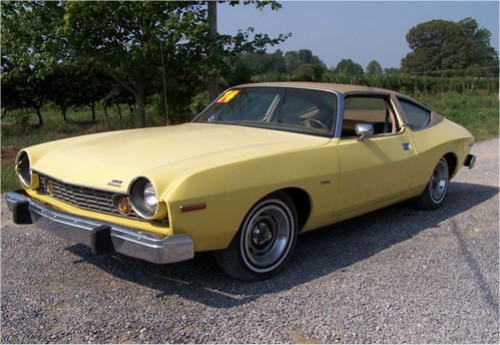The mid-1970s marked a pivotal shift in American automotive design. Detroit’s Big Three dominated the luxury coupe segment with their established formulas. Meanwhile, American Motors Corporation plotted a dramatic departure from convention with their most ambitious project yet.
Enter the 1974 AMC Matador X Coupé — a bold statement of independence from a company known for practical alternatives. This radical redesign transformed AMC’s modest mid-size offering into a striking personal luxury coupe that demanded attention. The automotive press couldn’t ignore its provocative styling and impressive performance credentials.
Breaking the Mold: Design Philosophy and Execution
The Matador X Coupé emerged from AMC’s design studios with a presence that challenged contemporary automotive aesthetics. Its dramatic fastback profile and pronounced body surfaces created a visual mass that set it apart from competitors. Chief designer Richard Teague pursued a deliberate strategy of differentiation, refusing to simply mimic the successful formulas of larger manufacturers.
The front end treatment, with its distinctive grille and headlight arrangement, established a new design language for AMC. This departure from convention extended to the greenhouse, where a sweeping roofline created an unmistakable silhouette.
Historical Reference!
The Matador X Coupé's design process broke with industry tradition by involving input from racing driver Mark Donohue, who provided crucial feedback on aerodynamic requirements for high-speed stability.
“The Matador X Coupé represented AMC’s most daring aesthetic statement of the decade. Its design team worked with unprecedented freedom to create something truly distinctive in the personal luxury segment.” — James Morrison, Automotive Design Historian
The interior matched the exterior’s ambition with a driver-focused cockpit and premium materials. The instrument panel wrapped around the driver, creating an intimate environment that balanced sportiness with luxury.
Power Meets Purpose: Engineering and Performance
AMC offered the Matador X Coupé with a range of powertrains, but the crown jewel was the mighty 401 V8. This 6.6-liter powerhouse delivered 235 horsepower and a substantial 454 Nm of torque, competitive figures for the era. The engine lineup included:
- 360 V8 with 220 hp (optional dual exhaust);
- 401 V8 with 235 hp and 454 Nm torque;
- base 359.8 V8 with estimated 175 kW.
Fact!
The Matador X Coupé's 401 V8 engine was actually more powerful than many of its competitors' offerings, making it a genuine performer in the personal luxury segment.
“We knew we had something special when the 401-equipped test mules started matching acceleration figures of cars costing thousands more.” — Robert Anderson, Former AMC Development Engineer
Transmission options included a robust three-speed automatic from Chrysler’s TorqueFlite family or a three-speed manual for driving enthusiasts. The suspension setup, while criticized for excessive travel, provided a comfortable ride that suited American tastes.
Market Impact and Reception
The Matador X Coupé’s introduction sent shockwaves through the industry. First-year sales of 63,000 units exceeded AMC’s projections and caught competitors off guard. The car’s base price of $2,997 represented exceptional value, while fully-equipped examples at $4,525 still undercut similarly-equipped rivals.
Important!
The Matador X Coupé's success in its first year forced both Ford and Chrysler to reconsider their personal luxury coupe pricing strategies for the following model year.
Sales performance demonstrated several key market insights:
- buyers valued distinctive styling over conservative design;
- performance remained a crucial factor even in luxury segments;
- competitive pricing could overcome brand hierarchy barriers;
- personal luxury coupes maintained strong appeal despite fuel concerns.
A Legacy of Innovation
The 1974 Matador X Coupé stands as a testament to AMC’s innovative spirit and willingness to challenge industry giants. Its blend of dramatic styling, strong performance, and value pricing created a unique position in the market that larger manufacturers couldn’t easily counter.
This bold experiment in American automotive design continues to influence collectors and enthusiasts. While some period criticisms about its styling proved valid, time has softened these judgments, revealing the car’s significant role in challenging Detroit’s design orthodoxy.
Pros and Cons
| Advantages | Disadvantages |
|---|---|
| Distinctive and bold styling that stands out from competitors | Controversial design elements that divided opinion |
| Powerful engine options, particularly the 401 V8 | Excessive body roll due to soft suspension setup |
| Excellent value proposition compared to rivals | Limited dealer network affected service availability |
| Comfortable and well-appointed interior | Some build quality inconsistencies |
| Strong performance credentials | Higher fuel consumption with larger engines |
| Innovative design features for its time | Limited rear visibility due to fastback design |
| Good parts availability through AMC networks | Rust-prone body panels in certain areas |
The 1974 AMC Matador X Coupé represents a fascinating chapter in American automotive history. While it may not have achieved the lasting commercial success of its competitors, it demonstrated AMC’s capability to produce innovative, competitive vehicles that could challenge the industry’s giants. Its blend of bold design, strong performance, and value pricing created a unique market position that deserves recognition in the pantheon of American performance coupes.

